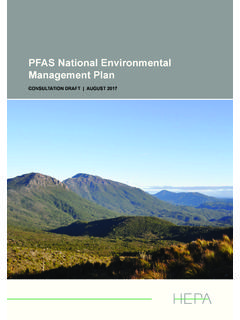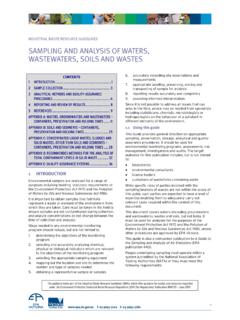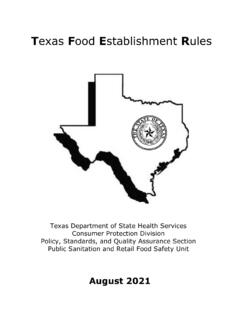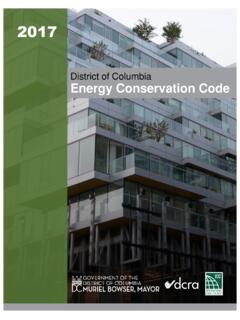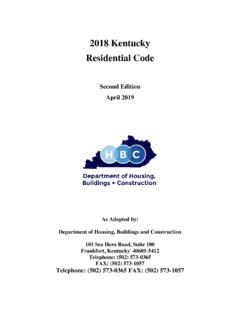Transcription of Code of practice onsite wastewater management
1 code of practice onsite wastewater management Publication * July 2016 * This replaces publication issued 2013 Guidelines for environmental management 1 Contents Quick find checklist .. 4 Chapter 1 Overview of the onsite wastewater Framework .. 5 Purpose .. 5 Legal status .. 5 Audience .. 6 wastewater definitions .. 6 Scope .. 6 Exclusions .. 6 Sewered and unsewered areas .. 6 Cumulative impacts .. 7 Legal framework .. 7 Environment Protection Act 1970 .. 7 State environment protection policies .. 8 Planning legislation and policies .. 8 Australian Standards .. 8 EPA Victoria .. 9 Local government .. 9 Land capability assessors .. 10 Building surveyors .. 11 onsite wastewater management system installers .. 11 Service technicians .. 12 Property owners and occupiers .. 12 Water Corporations .. 14 onsite wastewater treatment system approval processes .. 14 Manufacturers Approval process.
2 14 Property owners Permit process .. 15 Chapter 2 Introduction to onsite wastewater management .. 16 Sewage management options .. 16 Unsewered 16 Sewered areas .. 16 onsite and cluster scale options for new and existing developments .. 18 Effluent quality standards .. 18 Primary effluent standard .. 18 Secondary effluent standard (20/30/10 and 20/30) .. 19 Advanced secondary effluent standard (10/10/10) .. 19 Secondary effluent standard with nutrient reduction .. 19 Principles of sustainable water resource management .. 23 Waste hierarchy .. 23 Environmental sustainability .. 23 Organic matter and nutrients .. 23 Salts .. 23 Small lots .. 24 2 code of practice onsite wastewater management No offsite discharge of wastewater .. 24 Pump-out tanks .. 25 Effluent dispersal and recycling systems .. 26 Chapter 3 onsite wastewater management in unsewered areas .. 28 onsite wastewater planning 28 onsite treatment system 28 wastewater generation.
3 29 Minimum flow rates and organic loading .. 29 Increasing flow rates .. 29 High flow rates and organic loadings .. 29 Irregular, intermittent and surge flows .. 30 Reduced water flows .. 30 Organic loads .. 30 Daily wastewater flow rates .. 30 Calculations for minimum daily domestic flow rates .. 30 Commercial premises .. 32 Organic loads from commercial premises .. 32 Daily flow rates for community and commercial premises .. 32 Land capability assessment .. 34 LCA procedure .. 34 onsite land dispersal and recycling options .. 36 Primary treated effluent land application systems .. 36 Secondary treated effluent land application systems .. 38 Indoor uses for advanced secondary treated greywater effluent (10/10/10) .. 38 Setback distances .. 39 Treatment tanks .. 39 Flood-prone areas .. 39 Bores .. 39 Reserve 41 Absorption trench systems .. 41 Irrigation systems .. 42 System installation, use and 42 Service contracts.
4 42 Maintaining land application area (LAA) .. 43 Connection to sewer .. 43 Split systems .. 43 Primary treatment systems .. 43 Retrofitting secondary treatment 43 Existing secondary treatment systems .. 44 Chapter 4 onsite wastewater management in sewered areas .. 45 onsite systems allowed and not allowed in sewered areas: .. 45 Greywater overview .. 45 onsite sewerage options in sewered areas .. 45 Greywater treatment system installation, use and maintenance .. 46 Soil type assessment and site plan .. 46 Treated greywater recycling and reuse .. 46 Prohibited uses of greywater .. 47 Indoor use of treated greywater in single domestic households .. 47 Outdoor use of treated greywater .. 48 Appendix A: .. 50 Appendix B: Council Septic Tank Permit Application Process .. 52 Appendix C: Useful factors to consider when selecting an EPA-Approved onsite wastewater Treatment System .. 53 Appendix D: Septic Tanks.
5 54 3 code of practice onsite wastewater management 54 Sludge and scum .. 54 Desludging septic tanks .. 54 Septic tank failure .. 54 Positive actions a property owner can take to help a septic tank function well: .. 55 Indications of failing septic tanks and soil absorption trenches .. 55 Decommissioning treatment systems .. 55 Septic 55 Secondary treatment systems .. 56 Appendix E: Wick Trench and Bed System .. 57 Design and Installation .. 57 Design 57 Sizing calculations: .. 57 Installation .. 58 Maintenance .. 58 Appendix F: Urine-diversion toilets (UDT) .. 60 Appendix G: Sand filters .. 61 Appendix H: Salinity criteria for Sustainable wastewater Irrigation Schemes .. 62 Abbreviations .. 63 Glossary .. 64 68 Victorian Legislation, Regulations, Policies and Guidelines (as amended ) .. 68 Australian Standards and Guidelines .. 68 Previous EPA onsite wastewater Codes of 69 Literature .. 69 Maps .. 71 Useful contacts and websites.
6 72 Tables Table 1: Treatment systems allowed in sewered and unsewered areas .. 17 Table 2: onsite wastewater management options for sewered and unsewered areas .. 21 Table 3: Recommended maximum design irrigation rates for secondary effluent irrigation systems in sewered and unsewered 27 Table 4: Minimum daily wastewater flow rates and organic loading rates 1, 10 .. 33 Table 5: Setback distances for primary and secondary treatment plants and effluent disposal/irrigation areas in sewered and unsewered areas (where applicable) 1, 2, 6, 10, .. 40 Table 6: onsite wastewater collection and treatment options in sewered areas .. 45 Table 7: Options for treated greywater recycling in sewered areas 1 .. 47 Table 8: Recommended estimates for greywater flows 48 Table 9: Soil Categories and Recommended Maximum Design Loading/Irrigation Rates (DLR/DIR) for Land Application Systems 1, 2, 50 4 code of practice onsite wastewater management Quick find checklist Stakeholders Key Sections Building Surveyors Environmental Health Officers All chapters and appendices Land Capability Assessors and wastewater Consultant All tables , , , , Chapter 3 Chapter 4 Appendix A, B, E, G Manufacturers and Importers , , , Table 1, Table 2, Table 4, Table 6, Table 7 Appendix C Planners , , , , , , , Appendix B plumbing and Drainage Practitioners , , , Table 1, Table 2, Table 5, Table 6, Table 7 , , , Appendices B, C, D, E Premise owners and occupiers , , , , , , , Table 1, Table 2, Table 5, Table 6, Table 7 , , , Appendices B, C, D Water Corporations , , , , , , Table 1, Table 2.
7 Table 7 5 code of practice onsite wastewater management Chapter 1 Overview of the onsite wastewater Framework Purpose This code of practice ("the code ") provides standards and guidance to ensure the management of onsite wastewater (up to 5000 L/day) protects public health and the environment, and uses our resources efficiently. It has been written to support the onsite wastewater industry, regulators and premise owners design, install and/or manage sustainable sanitation and re-use systems in accordance with the Environment Protection Act 1970 and the State environment protection policies Waters of Victoria (SEPP WoV) and Groundwaters of Victoria (GoV). This code applies to wastewater (containing sewage) generated by a single domestic household or by multi-dwelling residential, commercial, industrial or institutional facilities. It provides guidance on: 1. the selection, approval, management and maintenance of onsite wastewater management systems which treat up to 5,000 litres (L) of wastewater per day 2.
8 Systems which treat up to 5,000 L/day of greywater to a quality fit for toilet flushing and cold water supply to clothes washing machines and/or land application and 3. land capability assessment procedures and wastewater flow calculations for designing effluent recycling and disposal systems. This code is based on current State, national and international best practice principles in public health and environmental protection, wastewater treatment, land capability assessment and effluent minimisation, reuse, recycling and disposal. This code , EPA Publication , supersedes: EPA Publication : code of practice onsite wastewater management EPA Publication Land Capability Assessment is superseded by this code together with the Victorian Land Capability Assessment (LCA) Framework (MAV 2014, as amended ). Legal status This code is the Victorian guideline for best practice management of onsite wastewater systems and associated land capability assessment.
9 It is referred to in Clause 32 of the State Environment Protection Policy - Waters of Victoria (SEPP WoV 2003). SEPP WoV is subordinate legislation to the Environment Protection Act 1970 ( the Act ) and states that: occupiers of premises need to manage their onsite wastewater system in accordance with Council Permit conditions and this code and Councils need to assess the suitability of land for onsite wastewater management and ensure that Permits are consistent with the guidance provided in this code (as amended ). The Act sets out legal obligations for Councils and premise owners (53J-53O). Key obligations are: Council may only permit the installation of an onsite wastewater system that is a type approved by the EPA [53M(7)(a)]. Council must refuse to issue a Permit if it considers that the site is unsuitable or the area available for the system is not sufficient [53M(6)]. Council must refuse to issue a Permit for a treatment system (or systems) that does not treat all the sewage from the premises [53M(7)(c)].
10 A person must not construct, install or alter an onsite wastewater system unless they have a Permit from Council to carry out the works (53L). A person must not use an onsite wastewater system until Council has inspected the system and issued a Certificate to Use. A penalty may be issued for non-compliance (53MB). The occupier of premises where an onsite wastewater system is installed must maintain it in accordance with the conditions in the Council Permit. A penalty may be issued for non-compliance (53N). Where an onsite wastewater system has caused pollution, appropriate compliance and enforcement action must be undertaken by Councils in line with their powers and responsibilities under the Act. The terms must and shall in this code indicate established best practice , requirements under the Act or other legislation and regulatory requirements. The term should refers to desirable or recommended procedures and methods.





